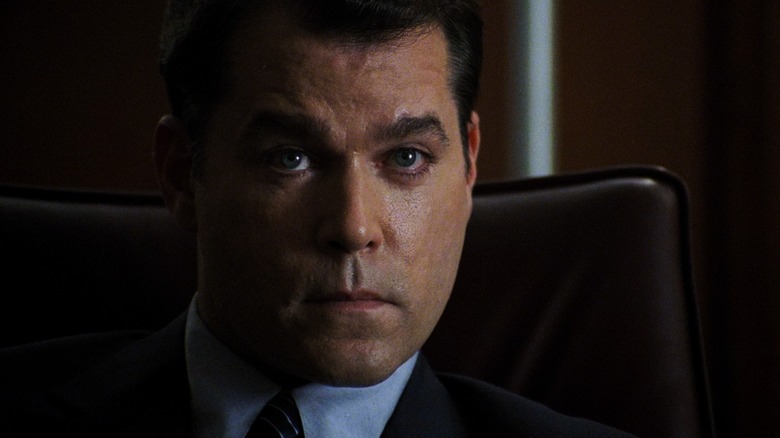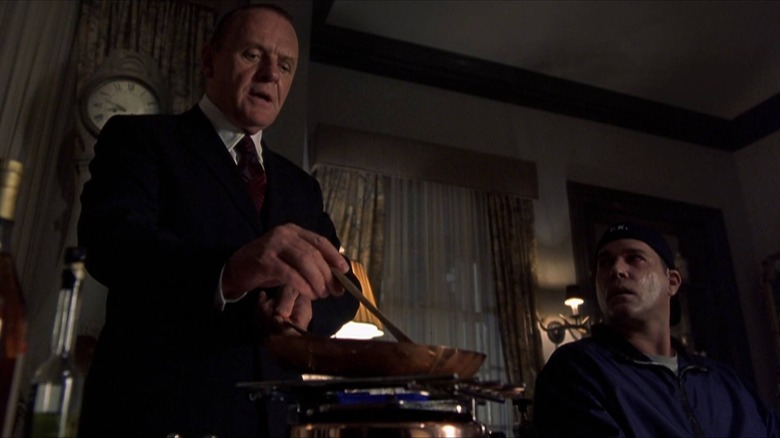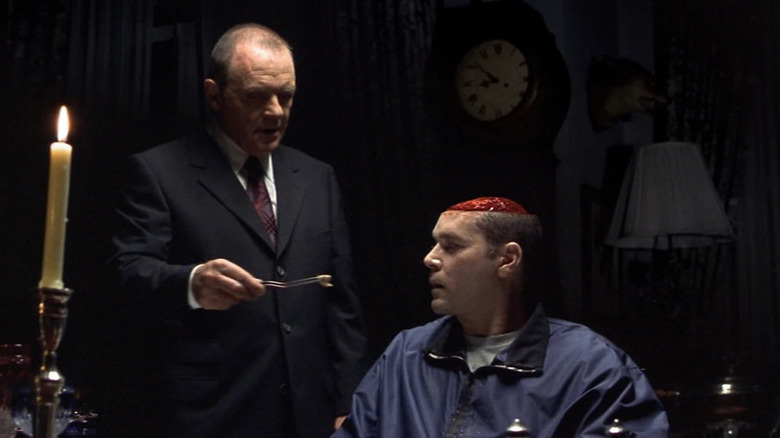The Disturbing Ray Liotta Scene We'll Never Get Out Of Our Brains
Ridley Scott's 2001 film "Hannibal" was critically panned upon its release. The consensus at the time was that the central relationship from Jonathan Demme's "The Silence of the Lambs" — that between FBI trainee Clarice Starling (Jodie Foster) and imprisoned cannibal serial killer Hannibal Lecter (Anthony Hopkins) — was relegated to a side story. The bulk of "Hannibal" was more focused on a violent revenge plot hatched by a character named Mason Verger (Gary Oldman), a Lecter survivor who sought to feed the criminal to a herd of trained boars.
Yeah, "Hannibal" gets pretty crazy.
It didn't help that Starling had been replaced by Julianne Moore, leading many to remain skeptical. It wasn't that Moore wasn't a perfectly capable actress, just that she was taking over for someone who'd won an Oscar for the role.
In "Hannibal," Ray Liotta played a callow Justice Department official named Paul Krendler, a character whose general malfeasance will lead to Clarice Starling's suspension from the case she was working on. Krendler reads as generally unsavory, an acting strength of Liotta's; he played "scumbags" quite well.
What happens to him next, well ... if you've seen the film, you know what's coming.
What Krendler eats
In the film's notorious climax, Lecter breaks into Krendler's house with Starling, where he drugs them both. When Starling awakens, she finds herself tied to a chair at a large dinner table. Krendler is similarly tied, wearing a baseball cap, seated in front of a skillet that Lecter is heating on a small portable stove. Lecter removes Krendler's cap, revealing a visible incision across his forehead. Talking all the while, Lecter pulls on the hair on the top of Krendler's head, removing his entire skullcap, and exposing his brain. Krendler is conscious but too drugged to understand what is happening. Lecter tears back a protective membrane around Krendler's brain, and, using an enormous curved scalpel, cuts into the grey matter. Krendler can feel nothing.
Lecter throws a small portion of Krendler's brain into the skillet, sautéing it gently. Krendler responds positively to the smell of the cooking meat. He (gulp) asks for a piece. Lecter, happy to engage in twisted acts of cannibalism, calmly feeds him a little. Krendler eats his own brain while Starling is understandably horrified. Later in the film, we'll find that Lecter has carved out larger a portion of Krendler's brain to store in a lunchbox for later. Lecter will end up sharing a piece with an unsuspecting child on an airplane.
To repeat: "Hannibal" gets pretty crazy.
A making-of video reveals how Scott and the SFX technicians achieved the effect. Liotta was outfitted with a green skullcap where the image of an exposed brain could be superimposed, while an animatronic Krendler was brought in for some of the more "physical" close-ups.
Demme vs. Scott
The brain-eating scene was a great acting showcase for Liotta — the character remained weirdly arrogant, even without a skull — but it also highlighted a distinct aesthetic gap between directors Jonathan Demme and Ridley Scott. Demme's 1991 film was certainly violent and bloody but was possessed of a deliberate, calming poise. The camera looked closely into people's eyes, giving the film a funereal feeling. Scott, a director not known for his subtlety, openly embraced the trashy, airport-pulp tone of Thomas Harris' original books, leaning full bore into the source material's more lurid aspects. "The Silence of the Lambs" can fairly be defined as a crime thriller. "Hannibal" is an out-and-out horror movie.
An article in the New York Times posited that Harris deliberately included extra gore in his "Lambs" sequel to spite film producer Dino De Laurentiis, who had already optioned the film right to "Hannibal" before it was complete. Surely, Harris must have thought, Hollywood wouldn't dare to make a film with a climactic autocannibalism scene.
Harris clearly underestimated Scott's gumption.
In the same behind-the-scenes video, Liotta was humble, concerned less with the extremity of the scene, and more with the thrill of acting opposite Hopkins, an actor he greatly admired. He also spoke about how uncomfortable it was taking a body cast to make the prosthetic version of himself (he was claustrophobic), the surreality of seeing the resulting rubber body, and what a giddy joy it was to do something so wicked and gross.
For Liotta, though, the most horrifying element of the scene was being cast as a character older than himself. Evidently, this was something that occurred frequently.
Liotta passed away on May 26, 2022, at the age of 67. May he rest in peace.


